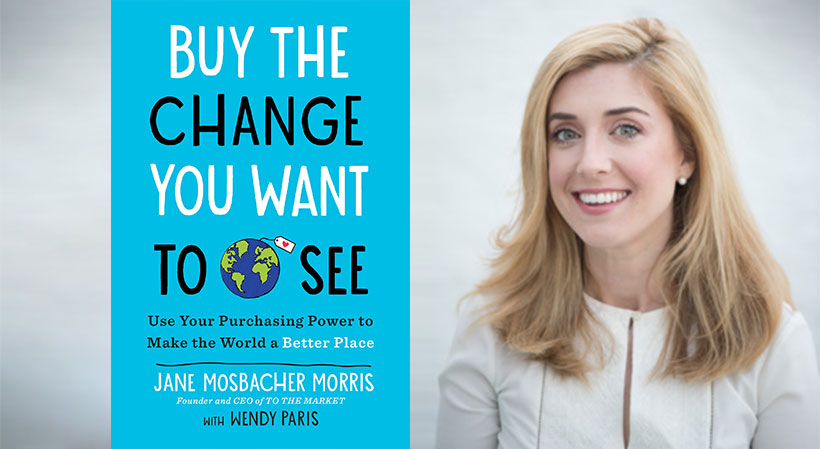The following is excerpted from “Buy the Change You Want to See” by Jane Mosbacher Morris with Wendy Paris, published by TarcherPerigee, an imprint of Penguin Publishing Group, a division of Penguin Random House, LLC. Copyright © 2019 by Jane Mosbacher Morris.
Many people feel increasingly compelled to establish and assert their own personal brand, for a variety of reasons. I think we’re seeing a huge uptick in customization because of this, and because it’s increasingly difficult to make any kind of unique, personal statement through clothing bought off the rack. The internet has made style more universal, and it’s easier than ever for factories to quickly replicate a high-fashion garment at a low price with fast-to-market production.
Meanwhile, the expansion of international distribution routes by new and existing carriers has turned those living in formerly inaccessible nations into viable (and eager) purchasers. We have global style leaders, and anyone can copy them. That’s always been the case somewhat, with ready-to-wear brands copying haute couture, but not to this degree, not as quickly, and not all around the world.
All these factors mean that a company like the Gap can sell the same skirt in multiple nations, and that a shirt you buy at a store like JCPenney might show up halfway across the world, with some small change to the design, at a store selling it for a third of the price. In today’s hyper-connected consumer environment, it feels like everything is everywhere.
Related: How to Use Personalization to Build Brand Loyalty:
I was in Asia in the summer of 2017, touring factories that produce apparel and shoes for the fashion conglomerate VF. (I’d recently begun serving on VF’s Responsible Sourcing Advisory Council). I saw seamstresses and shoemakers at a factory in Cambodia dressed in jeans and fitted T-shirts that could have come directly out of my own closet. [The company I started] To the Market also has a partner cooperative in Cambodia. There, I met with a young, upbeat co-op manager and jewelry maker wearing a ruffled denim miniskirt, espadrilles, and a black- and-white gingham shirt with two cotton lace ruffles down the front. I would wear any of those pieces, which she might have bought in any of the local boutiques in Phnom Penh. I’d felt the globalization of fashion but hadn’t yet considered how it might help vulnerable communities.
I was also aware of a growing trend in customizing products through how we purchase them, not just what we buy—the basis of the conscious consumer movement.
Recent Pew research on millennials found that members of this generation will pay more for eco-friendly products and that we believe our values are reflected in the brands we wear and carry.
Ordering T-shirts screen-printed by at-risk youths in the United States, for example, feels like an increasingly relevant way to make an important statement about ourselves, to say that we care about others and that we want to make a positive impact. This rise in conscious consumerism was evident among my peers, and among businesses I’d studied in business school and those I’d read up on since.
Like individuals, companies are working harder than ever to stand out. Companies need to create positive brand associations, and to make their values clear to consumers. This effort really matters in today’s increasingly crowded global marketplace, and in response to growing scrutiny from consumers, investors, and employees about business practices. Increasingly, companies are seeking to tell stories about themselves that show they are being “good citizens” in the world and that showcase their corporate social responsibility (CSR) efforts. In 2015, more than 80 percent of Fortune 500 companies published CSR reports, compared to only 20 percent just four years earlier—a sign of their focus.
Standing in the screen printing room of Freeset on that first trip, I had an immediate sense that its customization capability could be hugely marketable. I hadn’t yet connected this capacity to the economic and social pressures on businesses, nor did I have my own company at the time; I’d just begun working for the McCain Institute. But I was aware of the increasing drive to say something unique about ourselves and our businesses. At that moment, the fact that Freeset could add a custom logo to a product made by a survivor of human trafficking felt like a double incentive for a potential buyer—and got my mind working. When I returned from India, I couldn’t get Freeset and Sari Bari out of my mind. I began thinking about how I could add value to the work they were doing. How could I create more opportunities for the women employed there? I knew their products were well made and could compete with those of traditional manufacturers. But their story was a hundred times more compelling—if people had a chance to hear it.
I started researching the artisan industry. I read about the economies and market dynamics dominating the developing world. I talked with founders of artisan businesses to better understand their struggles and the most promising directions. I thought about the future of consumer behavior, and researched the product categories that were currently selling well and the types of retail businesses that were flourishing.
I’d launched plenty of initiatives at the State Department and the McCain Institute, but I’d never started a business. I knew I had an affinity for creating new projects, and a comfort with tapping into my network to locate the people and resources needed to make them work. I’d spent a decade learning how to identify the decision makers within an organization and fine-tuning my natural skill at rousing enthusiasm for a new idea that challenges the status quo. I’d also grown accustomed to looking for people’s personal motivations, and I largely accepted the reality that most people will support a new initiative or make real change in how they operate if they can see how it benefits them.
I bounced various business ideas off my friends and co-workers. I’d often show people the bags I’d brought back from Freeset and Sari Bari as a way to help illustrate the story and demonstrate the quality of their work.
I was thrilled to see how much people got it, and how easy it was to communicate my excitement about the founding and vision of these businesses. I knew I was onto something.
By the end of 2013, I had an initial outline of a business plan—at least the first iteration of it. I would connect with a couple dozen cooperatives employing vulnerable communities around the world, including Sari Bari and Freeset, and launch a website to sell their products to consumers here. None of these groups had an easy way to reach people in the United States. Even if they put up a website, they lacked the marketing budget necessary to help people find it. I’d do the promotion on the U.S. side and work to expand their market. I really believed there was a huge opportunity to increase the distribution of the two groups in India and others like them.
Sign Up: Receive the StartupNation newsletter!
I made a few key decisions about my business structure right away. We would be for-profit. I felt strongly that if my message to vulnerable communities was about the dignity of work and the power of economic opportunity, my operation needed to be sustainable on its own and generate profits for itself, its employees and its investors. Our social impact would come from who we employed and how they were employed, rather than through a give-back model. I was driven to start this company by my deep-seated belief in the transformational value of work—so evident on that first trip to India. All products we sold would be made by groups employing vulnerable communities in an ethical way. Our partners would be on the ground in these communities, paying a fair wage and offering safe working environments. I wanted a business model that would help vulnerable people to regain—or gain for the first time— their agency. I wanted to be a part of giving them choices.
In December 2013, I left the McCain Institute to get started. I spent the next nine months building up the back end of what would become To the Market’s direct-to-consumer website. My goal was to launch the site in time for the holiday shopping season of 2014.
I had a huge amount of work to do, from building a website, to figuring out pricing, to creating a distribution system, to finding the ethical producers whose work we could sell. I put the word out to people I knew and trusted. I told them about the business and that I was looking for groups to represent, specifically those that employed survivors of human trafficking, sexual assault or domestic violence, ongoing conflict, natural disasters, or stigmatized diseases. I got referrals through friends and colleagues, and made time to visit or asked friends to visit these groups. People really went out of their way to share the news about my developing company, which felt incredibly encouraging. I was so passionate about this idea and about my personal role in helping create economic opportunity. I think others stepped forward to help in response to my heartfelt commitment.
“Buy the Change You Want to See” is available now at fine booksellers and can be purchased via StartupNation.com.






